Rainy Season Construction Safety is the difference between a resilient site that stays productive and a chaotic project riddled with delays, incidents, and claims.
Wet weather heightens nearly every hazard—slips and trips, trench collapses, electrical shocks, material failures, poor visibility, and vehicle incidents.
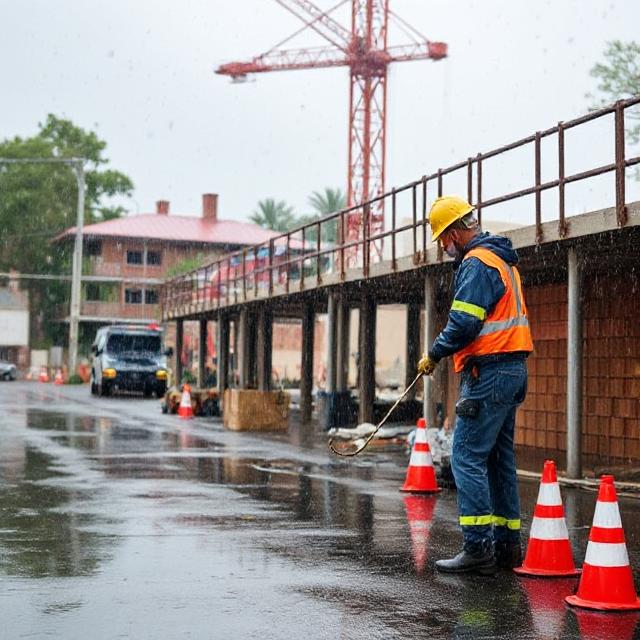
With the right planning, you can break the annual cycle of reactive fixes and instead launch the season with a structured, defensible plan that your crews trust and your client appreciates.
- Why Rainy Season Construction Safety matters now
- Pre-season hazard assessment for Rainy Season Construction Safety
- Storm-ready site layout and drainage
- Electrical and equipment controls in wet conditions
- Access, excavations, and traffic control in rain
- Materials, housekeeping, and slip/trip prevention
- People-focused controls: training, PPE, and communication for Rainy Season Construction Safety
- The Ultimate Pre-Season Preparation Checklist
- After the first storm: verify, learn, improve
- The payoff: safer teams, steadier schedules, stronger reputation
Why Rainy Season Construction Safety matters now
Storm intensity and frequency are changing, and long-range forecasts often miss convective downpours that overwhelm half-finished sites.
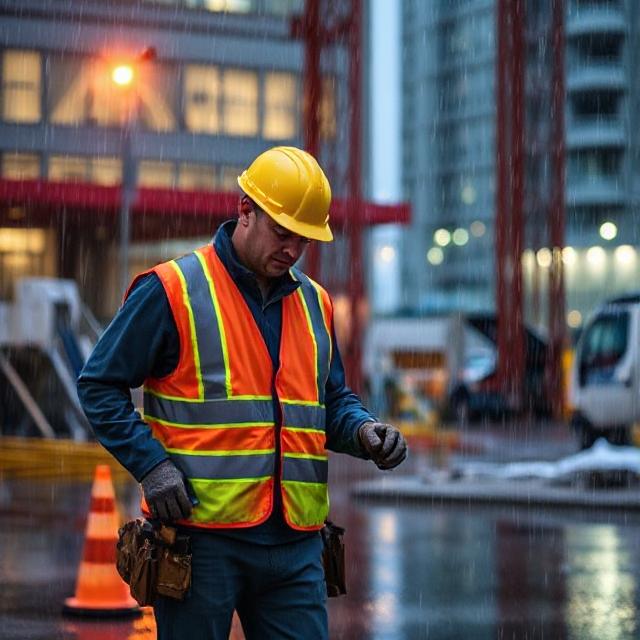
That’s why Rainy Season Construction Safety needs a proactive, all-hands approach anchored in the hierarchy of controls. Start by identifying where water will collect, how people move through those zones, and which operations (excavation, lifting, concrete, electrical) are most sensitive to moisture.
Cross-reference your findings with national guidance—see CCOHS for Canadian-focused rain hazards and controls, and OSHA for construction eTools—to align site controls with due diligence and industry best practice.
- CCOHS: Weather-related hazards and controls (ccohs.ca)
- OSHA Construction: Wet conditions and electrocution prevention (osha.gov)
Pre-season hazard assessment for Rainy Season Construction Safety
Walk the entire site with your superintendent, HSE lead, and forepersons. Flag gradient changes, unfinished drainage, vehicle pinch-points, and overhead exposures.
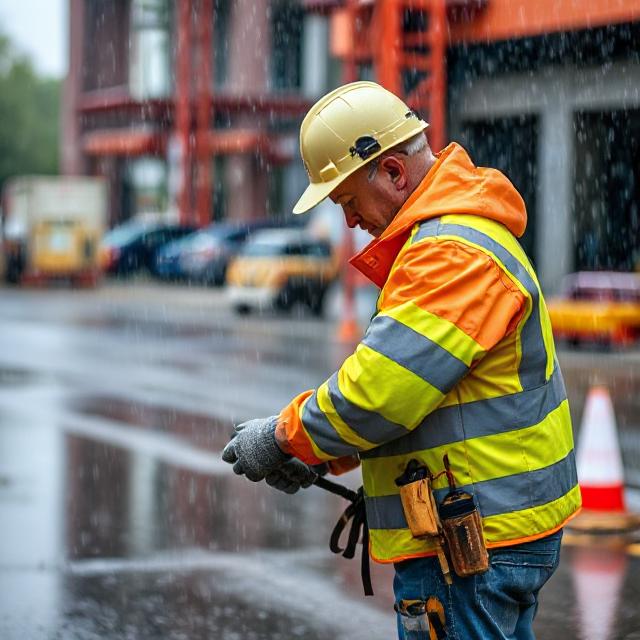
Use last year’s incident and near-miss data to map “repeat offender” areas—especially access paths, scaffold landings, container yards, and laydown zones. Document water-sensitive activities in your Job Safety Analyses and bake Rainy Season Construction Safety into pre-task talks.
If you maintain a safety knowledge base, link workers to internal refresher pieces like Emergency Signal Words in Occupational Safety and Heavy Equipment Hazards: How to Stay Safe on Site right in the digital JSA for quick context and reminders.
Storm-ready site layout and drainage
Water management is the backbone of Rainy Season Construction Safety. Verify that swales, sumps, and temporary culverts are installed before the first major event, not after. Protect slopes with silt fencing, wattles, and check dams to control both erosion and run-off velocity.
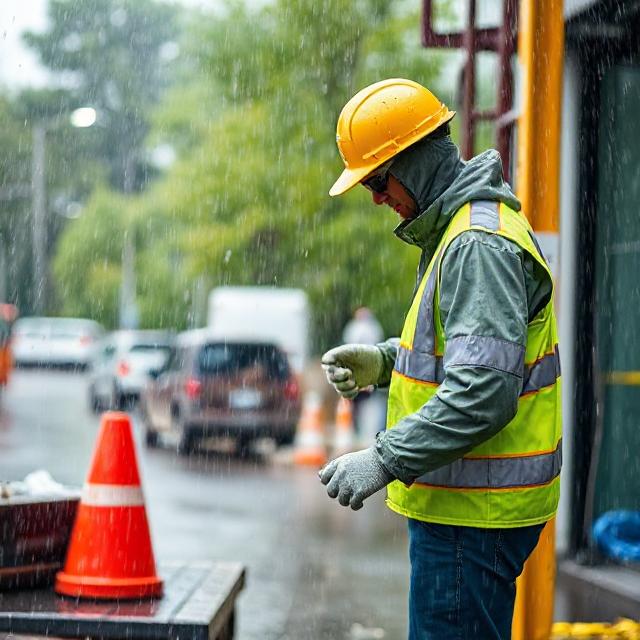
Elevate storage for cement, drywall, and electrical components on pallets under tight tarps in well-ventilated containers. Post storm maps at the site entrance and include them in your new-hire orientation so everyone knows where water goes, where to avoid parking, and how to reach muster points in a downpour.
For live alerts and watches, add Environment and Climate Change Canada’s weather warnings to your morning coordination routine.
- Environment Canada weather alerts (weather.gc.ca/warnings)
Electrical and equipment controls in wet conditions
Moisture magnifies electrical risk. For Rainy Season Construction Safety, specify GFCI protection on all 15/20A circuits and ensure all portable cords are heavy-duty, intact, and elevated off the ground where feasible.
Use weather-rated connectors and lockable covers at distribution panels. Park mobile generators on elevated, well-drained pads with drip trays and bonded grounding. For cranes and MEWPs, institute a wet-weather inspection line item: tires or tracks, anti-two-block devices, swing brakes, and emergency lowering controls.
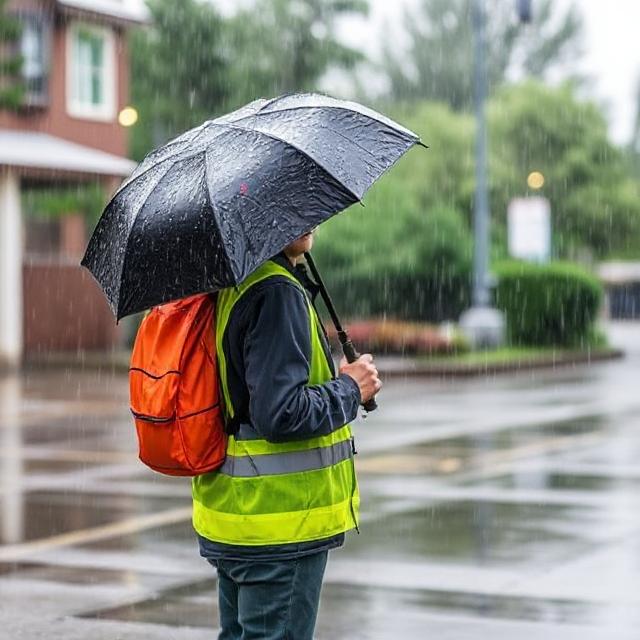
Prohibit makeshift covers that block exhaust or create heat buildup—use manufacturer-approved weather kits only. Reinforce the rule: never reset a tripped GFCI until you’ve inspected the circuit and load.
Access, excavations, and traffic control in rain
Rain transforms access routes into slip zones and excavations into collapse hazards. Stabilize high-traffic paths with compacted aggregate and non-skid matting; pre-stage additional matting to deploy during storms.
For trenches, daily (and post-rain) competent-person inspections are non-negotiable. If soils are Type C or known to slough, increase protective systems (sloping, shoring, or shielding) by a conservative margin and re-evaluate after each significant rainfall.
Integrate Rainy Season Construction Safety into your traffic plan by widening turning radii, adding rumble plates before pedestrian crossings, and enforcing reduced speed limits when surfaces are saturated.
Materials, housekeeping, and slip/trip prevention
Good housekeeping is amplified in wet weather. Keep sawdust, offcuts, and strapping out of water pathways so they don’t float and block drains.
Position sand or grit bins at building entrances and scaffold access points; assign a named person to replenish them daily during wet spells. Require anti-slip treads on temporary stairs and scaffold decks at transition points.
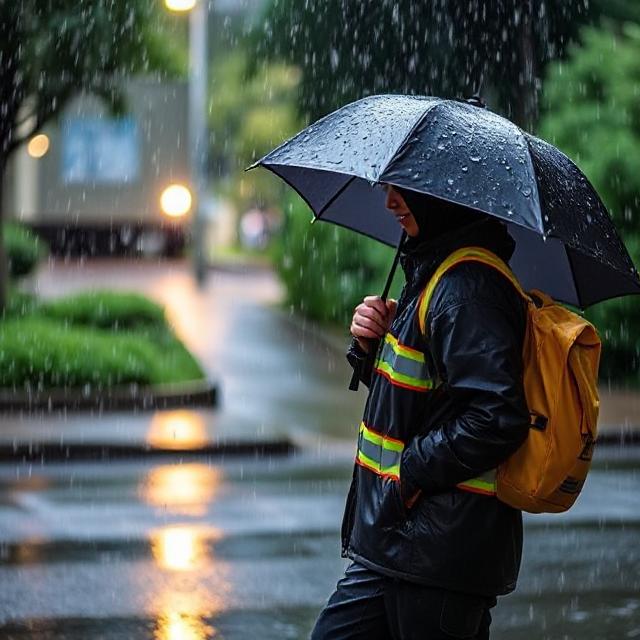
Store absorbents, squeegees, and submersible pumps on a clearly labeled Rain Kit cart so crews can respond within minutes.
These simple housekeeping moves are core to Rainy Season Construction Safety because they reduce minor injuries that otherwise cascade into lost time and schedule drag.
People-focused controls: training, PPE, and communication for Rainy Season Construction Safety
Reinforce the basics at the human level. Train crews on dry-hand/dry-glove rules for powered tools, spotting slick surfaces, and reading ground conditions before stepping from machines. Mandate high-grip, water-resistant boots and keep spare glove liners in the gang box to prevent cold-wet hand fatigue.
Visibility suffers in heavy rain—make Class 2/3 hi-vis with retroreflective striping mandatory for anyone near moving equipment. Establish a plain-language storm protocol: who calls the pause, where to shelter, when to resume.
Close each toolbox talk with a micro-drill (“If we lose visibility beyond 20 m, we stop, park, and muster at Point B.”). If your organization promotes a Zero Harm Culture, connect the message directly to Rainy Season Construction Safety so the season doesn’t erode core values.
The Ultimate Pre-Season Preparation Checklist
Before the first storm system hits, run this checklist and record it in your safety management system (auditable proof helps with client assurance and insurer queries):
- Governance & planning: Update wet-weather SOPs, include Rainy Season Construction Safety in JSAs, and align controls with ISO 45001 clauses on risk management and emergency preparedness.
- Weather intelligence: Subscribe the site phone and radio group to Environment Canada alerts; identify the threshold for “stop work” (e.g., lightning within 10 km, rainfall rate exceeding pump capacity).
- Site civil works: Finish temporary drainage, verify sump pumps (with backup power), mark overland flow paths, and protect inlets with cleanable screens.
- Power & lighting: Test all GFCIs, inspect cords/hoses, elevate connections, and confirm emergency lighting works in dark, rainy conditions.
- Access & egress: Lay non-slip mats on stairs, scaffold landings, and building entries; grade and gravel main paths; stock grit bins.
- Excavations: Confirm daily/post-rain inspections by a competent person; pre-stage trench shields; store spoil piles away from edges with proper set-backs.
- Cranes & MEWPs: Add wet-weather checks to pre-use inspections; define wind/rain limits; ensure operators know shutdown and securing procedures.
- Traffic management: Refresh line markings, add rumble plates near crosswalks, increase signage height for visibility in spray, and reduce speed limits in the TMP.
- Materials & laydown: Elevate water-sensitive stock; secure tarps; segregate chemicals and fuels with secondary containment to prevent sheen run-off.
- PPE & welfare: Stock high-grip boots, waterproof outerwear, glove liners, spare socks, and warming shelters; include hydration breaks—cool rain still dehydrates.
- Emergency readiness: Place Rain Kits (pumps, absorbents, squeegees, cones) where crews can reach them in 2 minutes; verify spill response plans.
- Communication: Conduct a storm drill; confirm emergency contact lists; add QR codes on noticeboards that link to your internal Rainy Season Construction Safety SOP for quick access.
External resources to benchmark your controls:
- ISO 45001 overview (iso.org)
- NIOSH: Electrical safety and wet environments (cdc.gov/niosh)
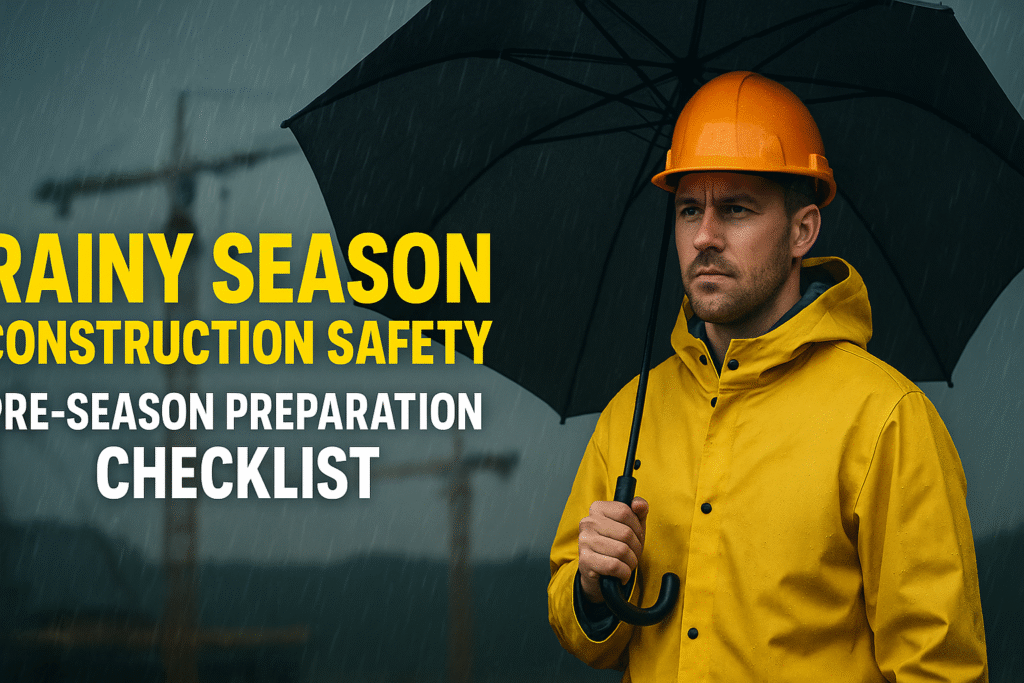
After the first storm: verify, learn, improve
Treat the first significant rainfall as a live test of Rainy Season Construction Safety. Conduct a structured after-action review the next morning:
where did water pool, what flooded, which pumps tripped breakers, and where did footing become treacherous? Log fixes with owners, deadlines, and budgets.
Share short video clips in your morning huddle so crews see both strong practices and gaps. Update your risk register, amend JSAs, and post a one-page “Storm Lessons” summary on the noticeboard and intranet—link it to related guidance like Preventing Cross-Contamination in Healthcare Food Service Units if your crews also service mixed-use sites, reinforcing the mindset that controls are portable across tasks and sectors.
The payoff: safer teams, steadier schedules, stronger reputation
When you lead with Rainy Season Construction Safety, you protect people, equipment, budgets, and your brand. Clients notice when sites stay orderly during foul weather, and regulators appreciate clean documentation that shows you anticipated the risk and controlled it.
Most importantly, your crews go home without injuries caused by predictable, seasonal hazards. Make this the year you stop improvising after the clouds open up and start executing a plan that’s already on the ground before the first drop falls.

Close your kickoff meeting with the commitment that every supervisor can explain, implement, and audit Rainy Season Construction Safety—then prove it with your checklist, your training, and your results.

No comments yet